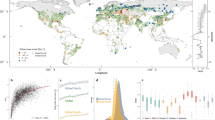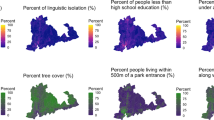Abstract
We assessed the association between the natural environment and asthma in 49,956 New Zealand children born in 1998 and followed up until 2016 using routinely collected data. Children who lived in greener areas, as measured by the normalized difference vegetation index, were less likely to be asthmatic: a 1 s.d. increase in normalized difference vegetation index was associated with a 6.0% (95% CI 1.9–9.9%) lower risk of asthma. Vegetation diversity was also protective: a 1 s.d. increase in the number of natural land-cover types in a child’s residential meshblock was associated with a 6.7% (95% CI 1.5–11.5%) lower risk. However, not all land-cover types were protective. A 1 s.d. increase in the area covered by gorse (Ulex europaeus) or exotic conifers, both non-native, low-biodiversity land-cover types, was associated with a 3.2% (95% CI 0.0–6.0%) and 4.2% (95% CI 0.9–7.5%) increased risk of asthma, respectively. The results suggest that exposure to greenness and vegetation diversity may be protective of asthma.
This is a preview of subscription content, access via your institution
Access options
Access Nature and 54 other Nature Portfolio journals
Get Nature+, our best-value online-access subscription
$29.99 / 30 days
cancel any time
Subscribe to this journal
Receive 12 digital issues and online access to articles
$119.00 per year
only $9.92 per issue
Buy this article
- Purchase on Springer Link
- Instant access to full article PDF
Prices may be subject to local taxes which are calculated during checkout




Similar content being viewed by others
References
Ulrich, R. S. View through a window may influence recovery from surgery. Science 224, 420–421 (1984).
James, P., Hart, J. E., Banay, R. F. & Laden, F. Exposure to greenness and mortality in a nationwide prospective cohort study of women. Environ. Health Perspect. 124, 1344–1352 (2016).
Mitchell, R. & Popham, F. Effects of exposure to natural environment on health inequalities: an observational population study. Lancet 372, 1655–1660 (2008).
Dadvand, P. et al. Green space, health inequality and pregnancy. Environ. Int. 44, 3–30 (2012).
Donovan, G. H., Michael, Y. L., Butry, D. T., Sullivan, A. D. & Chase, J. M. Urban trees and the risk of poor birth outcomes. Health Place 17, 390–393 (2011).
Hystad, P. Residential greenness and birth outcomes: evaluating the influence of spatially correlated built-environment factors. Environ. Health Perspect. 122, 1095–102, (2014).
Donovan, G. H. et al. The relationship between trees and human health: evidence from the spread of the emerald ash borer. Am. J. Prev. Med. 44, 139–145 (2013).
Alcock, I., White, M. P., Wheeler, B. W., Fleming, L. E. & Depledge, M. H. Longitudinal effects on mental health of moving to greener and less green urban areas. Environ. Sci. Technol. 48, 1247–1255 (2014).
Nutsford, D., Pearson, A. L. & Kingham, S. An ecological study investigating the association between access to urban green space and mental health. Public Health 127, 1005–1011 2013).
Pope, C. A. III & Dockery, D. W. Acute health effects of PM10 pollution on symptomatic and asymptomatic children. Am. Rev. Respir. Dis. 145, 1123–1128 (1992).
Grandjean, P. & Landrigan, P. J. Developmental neurotoxicity of industrial chemicals. Lancet 368, 2167–2178 (2006).
Lambert, K. A.et al. Residential greenness and allergic respiratory diseases in children and adolescents – a systematic review and meta-analysis . Environ. Res. 159, 212–221 2017).
Asher, I. & Pearce, N. Global burden of asthma among children. Int. J. Tuberc. lung Dis. 18, 1269–1278 (2014).
Lovasi, G. S., Quinn, J. W., Neckerman, K. M., Perzanowski, M. S. & Rundle, A. Children living in areas with more street trees have lower prevalence of asthma. J. Epidemiol. Commun. H. 62, 647–649 (2008).
Lovasi, G. S. et al. Urban tree canopy and asthma, wheeze, rhinitis, and allergic sensitization to tree pollen in a New York City birth cohort. Environ. Health Perspect. 121, 494–500 (2013).
Sbihi, H., Tamburic, L., Koehoorn, M. & Brauer, M. Greenness and incident childhood asthma: a 10-year follow-up in a population-based birth cohort. Am. J. Respir. Crit. Care Med. 192, 1131–1133 (2015).
Pilat, M. A. et al. The effect of tree cover and vegetation on incidence of childhood asthma in metropolitan statistical areas of Texas. HortTechnology 22, 631–637 (2012).
Dadvand, P. et al. Risks and benefits of green spaces for children: a cross-sectional study of associations with sedentary behavior, obesity, asthma, and allergy. Environ. Health Perspect. 122, 1329–1335 (2014).
Liddicoat, C. et al. Landscape biodiversity correlates with respiratory health in Australia. J. Environ. Manag. 206, 113–122 (2018).
Brokamp, C., LeMasters, G. K. & Ryan, P. H. Residential mobility impacts exposure assessment and community socioeconomic characteristics in longitudinal epidemiology studies. J. Expo. Sci. Env. Epid. 26, 428 (2016).
Nowak, D. J., Crane, D. E. & Stevens, J. C. Air pollution removal by urban trees and shrubs in the United States. Urban For. Urban Gree. 4, 155–123 (2006).
Ward Thompson, C. et al. More green space is linked to less stress in deprived communities: evidence from salivary cortisol patterns. Landscape Urban Plan. 105, 221–229 (2012).
Jones, B. A. Work more and play less? Time use impacts of changing ecosystem services: the case of the invasive emerald ash borer. Ecol. Econ. 124, 49–58 2016).
Rook, G. A. Regulation of the immune system by biodiversity from the natural environment: an ecosystem service essential to health. Proc. Natl Acad. Sci. USA 110, 18360–18367 (2013).
Integrated Data Infrastructure (Statistics New Zealand, 2017); http://www.stats.govt.nz/browse_for_stats/snapshots-of-nz/integrated-data-infrastructure.aspx
Hanski, I. et al. Environmental biodiversity, human microbiota, and allergy are interrelated. Proc. Natl Acad. Sci. USA 109, 8334–8339 (2012).
Yazdanbakhsh, M., Kremsner, P. G. & Van Ree, R. Allergy, parasites, and the hygiene hypothesis. Science 296, 490–494 (2002).
Ege, M. J. et al. Exposure to environmental microorganisms and childhood asthma. N. Engl. J. Med. 364, 701–709 (2011).
Douwes, J. et al. Farm exposure in utero may protect against asthma, hay fever and eczema. Eur. Respir. J. 32, 603–611 (2008).
Douwes, J. et al. Lifelong farm exposure may strongly reduce the risk of asthma in adults. Allergy 62, 1158–1165 (2007).
Takayama, N. et al. Emotional, restorative and vitalizing effects of forest and urban environments at four sites in Japan. Int. J. Environ. Res. Public Health 11, 7207–7230 (2014).
Fan, Y., Das, K. V. & Chen, Q. Neighborhood green, social support, physical activity, and stress: assessing the cumulative impact. Health Places 17, 1202–1211 2011).
Aniansson, G. et al. Nasopharyngeal colonization during the first year of life. J. Infect. Dis. 165, S38–S41 (1992).
Jakobsson, H. E. et al. Short-term antibiotic treatment has differing long-term impacts on the human throat and gut microbiome. PloS ONE 5, e9836 (2010).
Johnston, S. L. et al. The relationship between upper respiratory infections and hospital admissions for asthma: a time-trend analysis. Am. J. Respir. Crit. Care Med. 154, 654–660 (1996).
Norton, D. A. Species invasions and the limits to restoration: learning from the New Zealand experience. Science 325, 569–571 (2009).
Vila, M. et al. Ecological impacts of invasive alien plants: a meta-analysis of their effects on species, communities and ecosystems. Ecol. Lett. 14, 702–708 (2011).
Fountain, D. W. & Cornford, C. A. Aerobiology and allergenicity of Pinus radiata pollen in New Zealand. Grana. 30, 71–75 (1991).
Nielsen, A. B., van den Bosch, M., Maruthaveeran, S. & van den Bosch, C. K. Species richness in urban parks and its drivers: a review of empirical evidence. Urban Ecosyst. 17, 305–327 (2013).
Markevych, I. et al. Surrounding greenness and birth weight: results from the GINIplus and LISAplus birth cohorts in Munich. Health Place 26, 39–46 (2014).
Black, A. The IDI Prototype Spine’s Creation and Coverage. Statistics New Zealand Working Paper No 16–03 (Statistics New Zealand, Wellington, 2016).
New Zealand Ministry of Health. Annual Update of Key Results 2014/15: New Zealand Health Survey (New Zealand Ministry of Health, Wellington, 2015).
Fuertes, E. et al. Residential greenness is differentially associated with childhood allergic rhinitis and aeroallergen sensitization in seven birth cohorts. Allergy 71, 1461–1471 (2016).
Chander, G., Markham, B. L. & Helder, D. L. Summary of current radiometric calibration coefficients for Landsat MSS, TM, ETM+, and EO-1 ALI sensors. Remote Sens. Environ. 113, 893–903 (2009).
NZ Roads (Addressing) Set (Land Information New Zealand, 2016); https://data.linz.govt.nz/set/88
Sonnenschein-van der Voort, A. M. et al. Preterm birth, infant weight gain, and childhood asthma risk: a meta-analysis of 147,000 European children. J. Allergy Clin. Immunol. 133, 1317–1329 (2014).
Aboal, J. R., Fernandez, J. A., Boquete, T. & Carballeira, A. Is it possible to estimate atmospheric deposition of heavy metals by analysis of terrestrial mosses?. Sci. Total. Environ. 408, 6291–6297 2010).
Strachan, D. P. & Cook, D. G. Parental smoking and childhood asthma: longitudinal and case-control studies. Thorax 53, 204–212 (1998).
Goldberg, S. et al. Asthma prevalence, family size, and birth order. Chest 131, 1747–1752 (2007).
Tagiyeva, N. et al. Parental occupation is a risk factor for childhood wheeze and asthma. Eur. Respir. J. 35, 987–993 (2010).
Xu, H., Simonet, F. & Luo, Z. C. Optimal birth weight percentile cut-offs in defining small- or large-for-gestational-age. Acta. Paediatr. 99, 550–555 (2010).
Salmond, C. E. & Crampton, P. Development of New Zealand’s deprivation index (NZDep) and its Uptake as a national policy tool. Can. J. Public Health 103, S7–S11 (2012).
Rothman, K. J., Greenland, S. & Lash, T. L. Modern Epidemiology. Modern Epidemiology. 3rd edn. (Wolters Kluwer, Philadelphia, 2008).
Acknowledgements
Thanks to C. Brooks for his valuable insights on mechanisms linking the natural environment and asthma. The results in this paper are not official statistics. They have been created for research purposes from the IDI, managed by Statistics NZ. The opinions, findings, recommendations and conclusions expressed in this paper are those of the authors, not Statistics NZ. Access to the anonymized data used in this study was provided by Statistics NZ under the security and confidentiality provisions of the Statistics Act 1975. Only people authorized by the Statistics Act 1975 are allowed to see data about a particular person, household, business or organization, and the results in this paper have been confidentialized to protect these groups from identification and to keep their data safe. Careful consideration has been given to the privacy, security and confidentiality issues associated with using administrative and survey data in the IDI. Further detail can be found in the privacy impact assessment for the IDI available from www.stats.govt.nz.
Author information
Authors and Affiliations
Contributions
G.H.D. developed the research idea with J.D., conducted the analysis and took the lead on writing the paper. D.G. conducted all geo-spatial analysis and wrote the geo-spatial section of the methods. I.L. provided air quality data, wrote the air-quality section of the methods and reviewed drafts of the paper. J.D. developed the research idea with G.H.D., wrote significant parts of the paper and reviewed multiple drafts of the paper.
Corresponding author
Ethics declarations
Competing interests
The authors declare no competing interests.
Additional information
Publisher’s note: Springer Nature remains neutral with regard to jurisdictional claims in published maps and institutional affiliations.
Supplementary information
Supplementary Table 1
Definitions of land-cover types for New Zealand land-cover database (LCDB) version 4.1 (1 denotes land-cover types included in variable describing the total number of natural land-cover types in a child’s residential mesh-block; 2 denotes land-cover types included in variable describing number of native land-cover types)
Rights and permissions
About this article
Cite this article
Donovan, G.H., Gatziolis, D., Longley, I. et al. Vegetation diversity protects against childhood asthma: results from a large New Zealand birth cohort. Nature Plants 4, 358–364 (2018). https://doi.org/10.1038/s41477-018-0151-8
Received:
Accepted:
Published:
Issue Date:
DOI: https://doi.org/10.1038/s41477-018-0151-8
This article is cited by
-
Housing typologies and asthma: a scoping review
BMC Public Health (2023)
-
Residential surrounding greenness is associated with improved lung function in adults: a cross-sectional study in eastern China
BMC Public Health (2023)
-
Residential greenness, asthma, and lung function among children at high risk of allergic sensitization: a prospective cohort study
Environmental Health (2022)
-
Shortcomings of the normalized difference vegetation index as an exposure metric
Nature Plants (2022)
-
Association of individual green space exposure with the incidence of asthma and allergic rhinitis: a systematic review and meta-analysis
Environmental Science and Pollution Research (2022)



